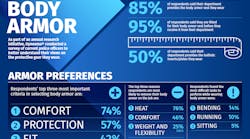In 1983, just out of college, my retail uniform career began. At that moment in time, the number one uniform trouser worn by law enforcement personnel was constructed from a 55% Polyester/45% Wool, 16-ounce, Elastic Weave fabric. Its styling was a traditional four-pocket dress pant with quarter top pockets and keystone beltloops. This trouser still exists today but is no longer the number one worn option.
Why not? Innovation. Advances in technology have made other options desirable, resulting in uniform attire and gear that is more efficient, functional, comfortable and practical.
Still, law enforcement agencies are heaped in tradition, and “that is the way we've always done it” is the mantra of many departments. But you can update a uniform program without compromising tradition. Here's what you should consider.
Fabrics
The evolution of fabrics has been significant. The 1950s ushered in wash-and-wear cotton, allowing for more wrinkle-free and durable uniforms. Two decades later, machine washable wool offered the same comfort and quality of traditional wool minus the cost of dry cleaning. Today, the buzz surrounds so-called smart textiles. These smart fabrics have been developed with new technologies that provide added value to the wearer. Smart fabrics can regulate heat, communicate and even change color. They can adjust to your body temperature and muscle movements besides decreasing wind resistance.
These performance enhancing smart textiles will have a significant impact on the athletic, law enforcement and military industries, and choosing the one that best fits your needs can increase productivity. Look for fabrics that protect against UV rays, or fabrics with built-in thermo climate control depending on your geographic environment.
Functionality
Functionality is synonymous with usefulness. How well does your uniform and personal equipment do its job? Today officers are asked to carry massive amounts of equipment: a firearm, non-lethal weapon, multiple handcuffs, flashlight, defensive spray, portable radio and mic, body camera, baton, etc. The shear weight and number of equipment pieces has led to dispersing these items across the body with additional pocketing in shirts, pants, jackets and body armor carriers. Many garments today include tabs to attach body cameras and radio mics for ease of use.
An officer’s body is their office, and the office must be set up efficiently. You should look at personal equipment for innovation and enhanced functionality. New safety handcuffs and leg restraints, weapon mounted and higher lumen output flashlights in smaller sizes, lighter body armor with higher protection characteristics, stronger and lighter weigh collapsible batons, and body cameras with an appropriate field of view and correctly managed transfer of evidence can make officer safety and productivity a priority.
Comfort
“If your feet hurt, your whole-body hurts” could not be any truer than when discussing law enforcement footwear. Here, too, technology has over the decades improved law enforcement footwear. Highly functional shoes created by engineers have resulted in footwear that fits well and helps the wearer better perform tasks. Composite shanks versus metal shanks reduce shoe weight and created a metal detector approved product. EVA outsoles and midsoles provide much-needed comfort and cushioning. The adaption of woven nylon fabric replaced leather in the footwear upper allowing additional air circulation for breathability.
Law Enforcement footwear also inherits technologies from the athletic industry. Cushioned insoles for heel and forefoot (ball of the foot made up of metatarsal bones) strike comfort came from athleticwear. Other characteristics to consider are side zippers or lace zippers for ease to doff or don footwear. Depending on the climate footwear is available with waterproof, insulation or bloodborne pathogen materials. Depending upon job function footwear is available with composite or steel toe protection.
One thing innovation and technology hasn't changed is footwear color. Be prepared to wear black or black.
Steve Zalkin is president of the North American Association of Uniform Manufacturers and Distributors. Contact him at [email protected] with questions about your uniform program and personal equipment needs.



